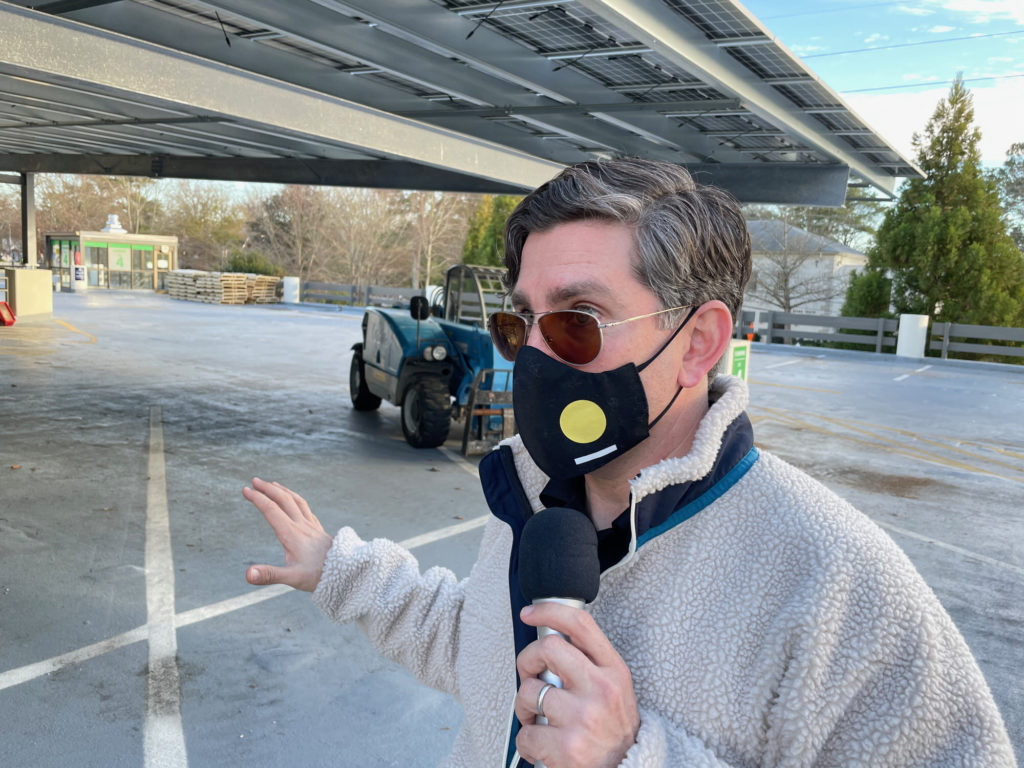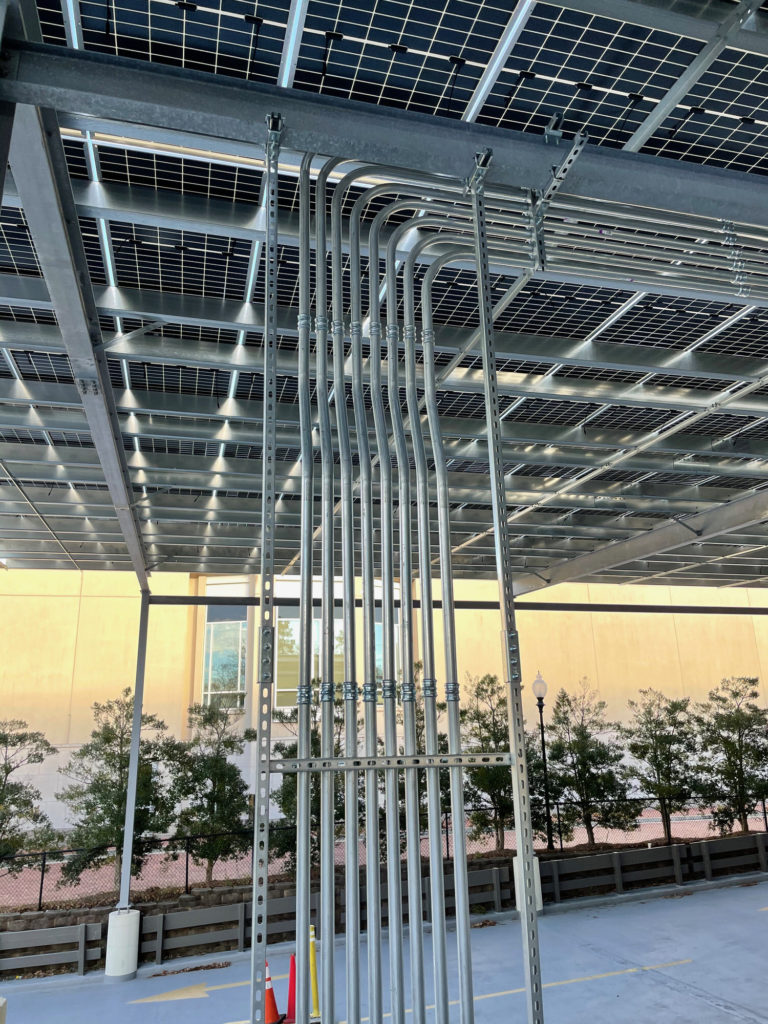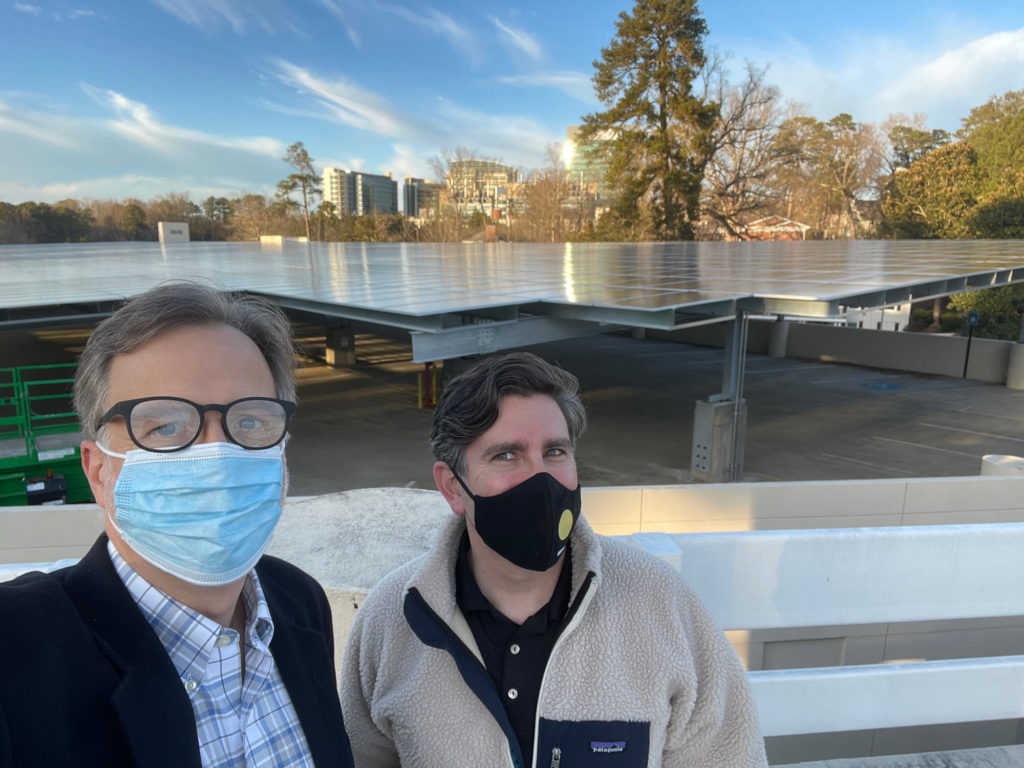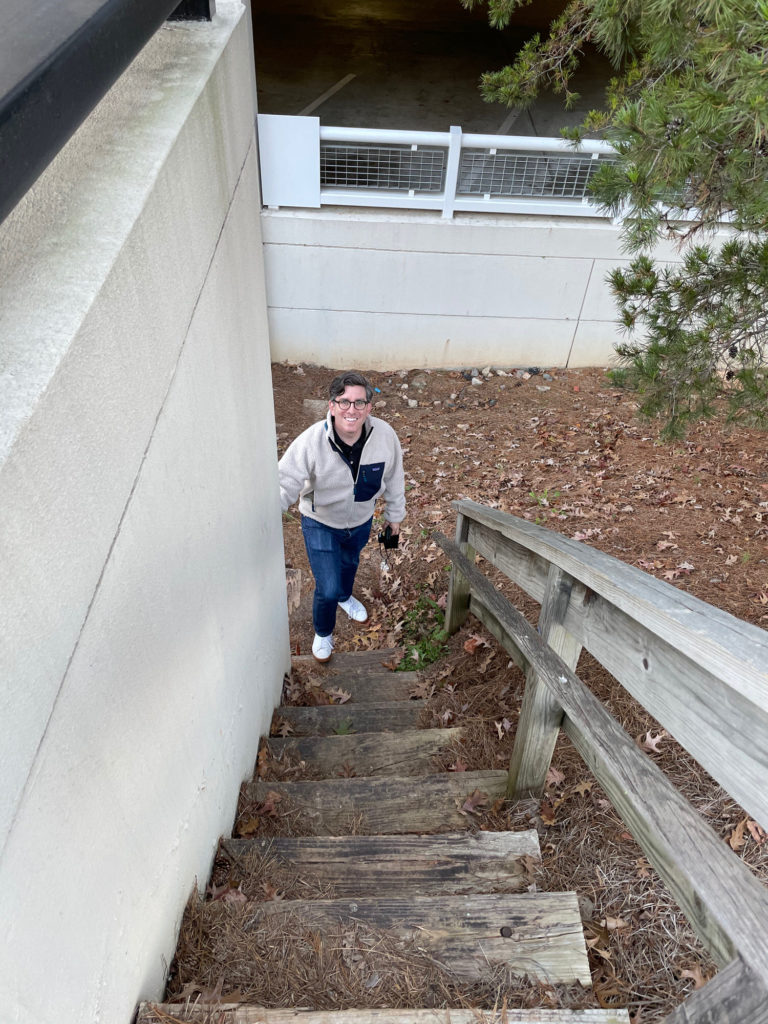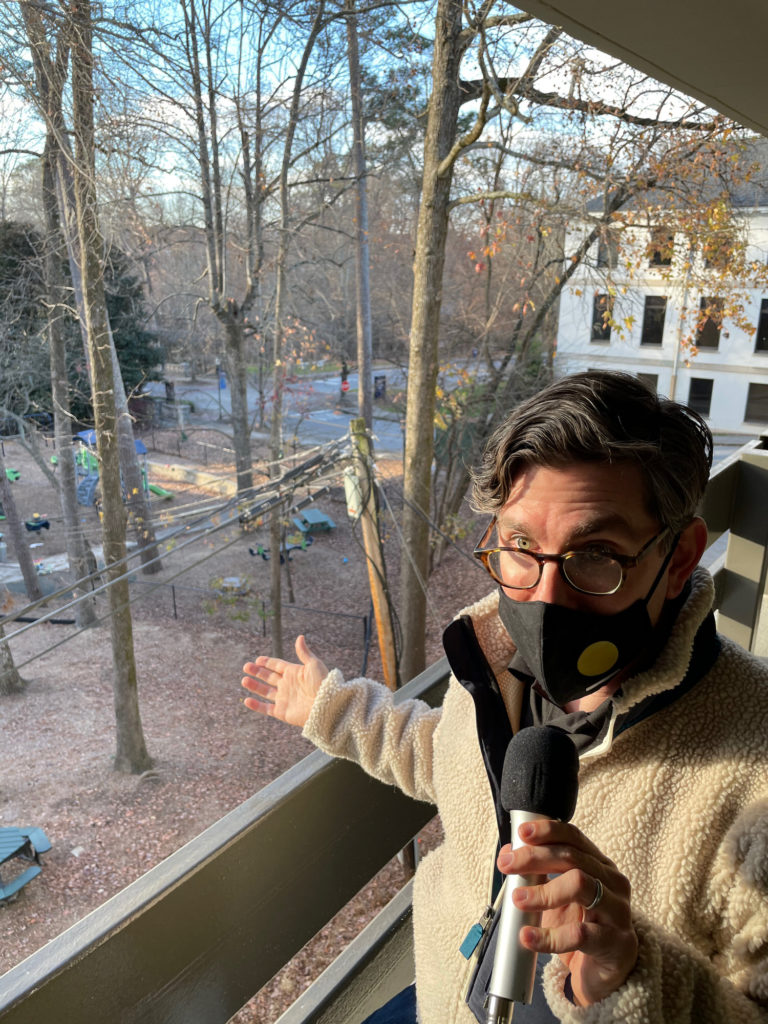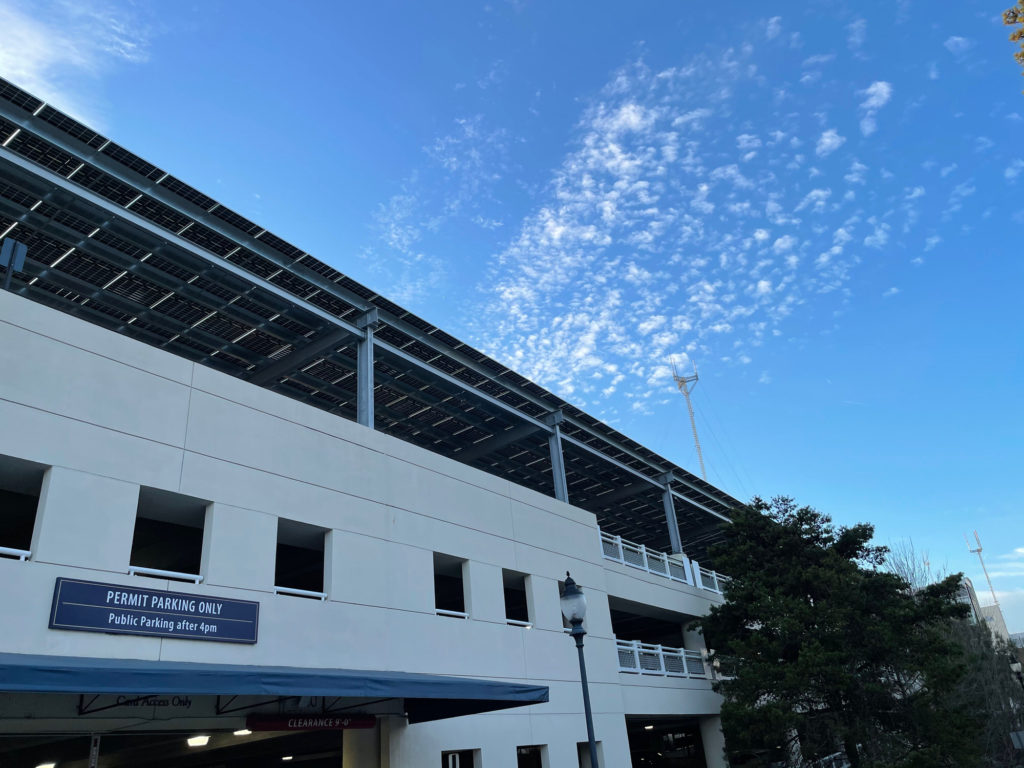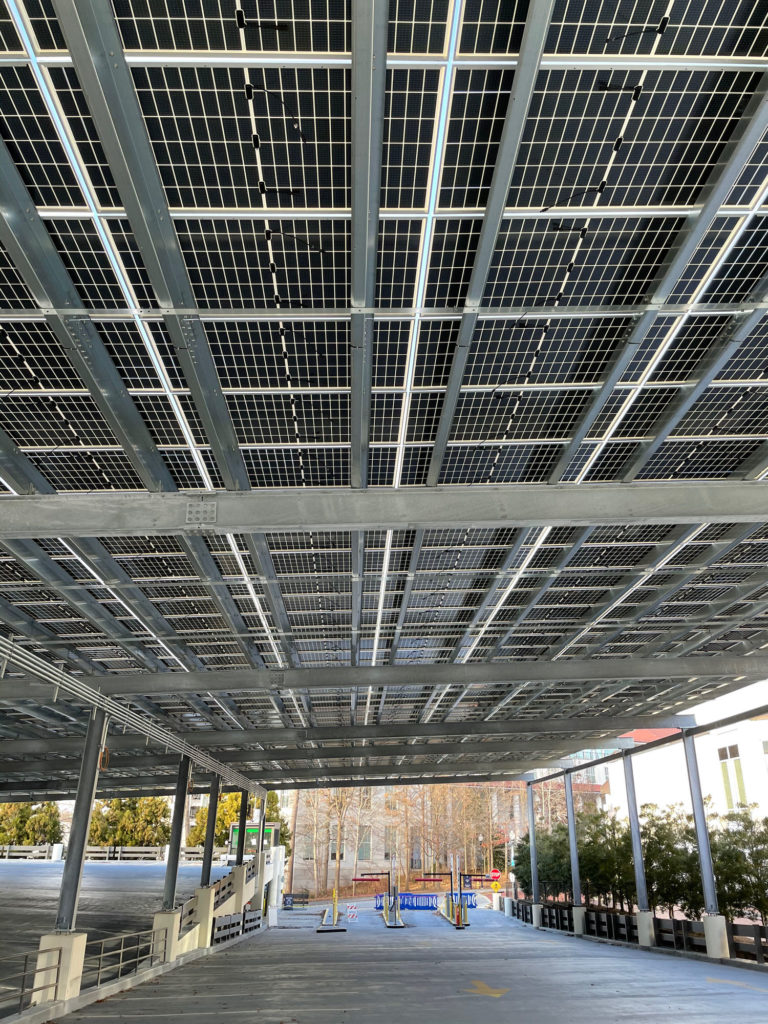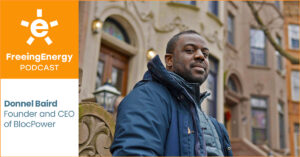
Strap on your walking shoes and listen in as Michael Chanin, founder and CEO of Cherry Street Energy, takes us on a walking tour of the beautiful Emory University Campus in Atlanta GA where one of the largest and coolest deployments of on-site solar power at a higher education institution in the Southeast is being developed. From seven stories up on a high rise parking deck with its sea of solar panels back down to ground level where electrical conduit becomes a work of art, Chanin shares details with podcast host Bill Nussey about the vision, the leadership, and some deft engineering skills being used to help Emory meet aggressive greenhouse gas emissions reduction goals while providing electricity to the campus at rates lower than the local utility.
Here are a few of the insights Michael shares on our tour…
The built environment of the future will incorporate renewable power on every structure that can support it.
It’s so important to talk about jobs in this reimagined renewable energy economy, particularly the importance of skilled labor.
The coordination and timing across all sorts of skilled labor are under-appreciated, both in our industry and definitely outside of it…
You can also listen to this podcast and others in our series on these platforms:


The Emory University Solar Project Tour
Learn more
- For more information on Emory’s sustainability efforts, visit the Sustainability Initiatives website
- For more information on Cherry Street Energy and their Shine On campaign, visit Cherry Street Energy
- Learn about third-party solar ownership at DSIRE or check out their paper here.
- Partnership Highlight: Michael Chanin, CEO of Cherry Street Energy, Emory University
Transcript
Bill Nussey:
We’re going to try something a little different today. I’m going to share my visit to one of the coolest commercial scale solar installations I’ve seen, and with me is the orchestra leader of this project, Michael Chanin, the CEO and founder of Cherry Street Energy. Michael, thanks for the tour today and welcome to our podcast.
Michael Chanin:
It’s great to be on it. Thank you for including me.
Bill Nussey:
I’m standing out here in front of the Fishburne Parking Deck of Emory University here in Atlanta, Georgia. And right in front of me is a three, four story parking deck that goes on pretty far in all directions. It’s outside of the Goizueta Business School. Behind me are two giant green boxes, the kind of boxes that you almost never pay any attention to, you drive by all the time, but these are the boxes that connect this part of campus to the grid.
Michael Chanin:
Emory is an energy island. They own their own distribution. For the majority of campus, you’ll see here these two transformers, and then their underground distribution network powers all of the buildings around campus. One of the great opportunities to incorporate distributed energy on campus is the 35 parking decks.
Bill Nussey:
There’s 35 parking decks here?
Michael Chanin:
35 parking decks on Emory’s main campus.
Bill Nussey:
I’ve traveled far and wide and met many people who are visionaries, but Michael might be the only one I could describe as a prophet of solar… Certainly this community scale, commercial scale solar that he and his company have really nailed down. Can you give me a real quick introduction to Cherry Street Energy? How did it come into being and why did you do it?
Michael Chanin:
Of course. There’s a huge introduction to jump off into, especially knowing with whom you typically speak. I’ve obviously got the benefit of being proximate to you. Living in the same community has such privilege because people have introduced us any number of times to get to learn from all of the things that you see much further a field to what’s directly in front of us. Cherry Street Energy is a power company.
Michael Chanin:
And amazingly, when we first got Emory’s business, it was through Ciannat Howett, who’s a wonderful advocate for sustainability and equity, as we think about energy and its distribution. We were working on one building. It’s a joint venture between Emory and Georgia Tech, the Library Services Center. It’s for all the books that are in purgatory.
Michael Chanin:
Emory and Georgia Tech have out of circulation kept them in this space and we were going to put them there, but it’s this whole joint venture between two universities, an incredibly complicated procurement process. And one night at a cocktail event, Ciannat says to me, “Michael, it’s so exciting, but it’s not big enough.” So the next day I wrote her this note that said, “I heard you and I understand that you say it’s not big enough.”
Michael Chanin:
And Shan Arora, who was at Southface at the time and a double Emory degree guy, had sent me this spreadsheet that he put together of 35 parking decks on campus. I forwarded it to Ciannat and I said, “I’ve got a solution, not an idea. And it’s a big one. But we could meaningfully address what you want. We can take metal bending come underground, and we’ll put in brand new transformers. And we’ll power them to allow campus to incorporate renewable power.”
Michael Chanin:
We’re not going to walk up from where this is going in and this will feed campus anytime that it’s shining on the parking deck ahead. I’ll show you as we go up there some of the considerations one has when taking 35 parking decks on a college campus and then trying to say, “How do we systematically do this in a way that works on campus, takes into account your existing built environment, but also does so in a way that is for a 20 year contract and with a campus that already has a pretty meaningful master service plan for its continued growth, and then multiple campuses across the state?”
Bill Nussey:
Wow. A power company. You may be the only person I’ve met that describes their solar company that way. Why is it a power company?
Michael Chanin:
The built environment of the future will incorporate renewable power on every structure that can support it. And five years ago, when the laws for those in our trade would call the third-party ownership laws governing the distribution of electricity in Georgia, the territorial acts were amended to allow for a third-party to sell electricity directly to an off-taker, to a customer like Emory University.
Michael Chanin:
The first time a private sale of electricity happened from renewable power to a customer was between our company in Macon, Georgia, my hometown. That was in 2016.
Bill Nussey:
And that was the first time that power was sold that didn’t go through the monopoly utilities here?
Michael Chanin:
Correct.
Bill Nussey:
This is a really interesting history, and Georgia was one of the last states to allow for third-party ownership. And if it’s a topic that you want to learn more about, I encourage you to go back and listen to our podcast interview with Mike Dudgeon, who was one of the architects of that law.
Michael Chanin:
He drafted the enabling legislation. It was called the Solar Power Free-Market Financing Act of 2015. And the marketplace, which they created, a Republican house senate and governor, all unanimous was our value proposition to our customers like Emory at no cost for the infrastructure, we sell them competitively priced electricity, and we allow them to achieve their sustainability goals. As a power company, our vision is power for all.
Michael Chanin:
And the way that we think about what that means in this re-imagined renewable energy economy is that we had to create a framework and a platform to allow folks to buy something that they’ve never thought about buying, which is electricity. Most often, as you say, it is a monopoly. We had to educate our customers, one, about our partnership with the utility. We have no interest in being an antagonist. And for the foreseeable future, the grid is going to be the backbone of our energy distribution infrastructure.
Michael Chanin:
The question that we have in communities like Atlanta is, how do we do this the right way, but how do we do this in a way that’s best for rate payers, best for state leadership, and how do we keep our economy vibrant as well as supporting this inevitable transition? We believe that both our business model, as well as our broad industry partnership with the skilled labor that is necessary to build, as Bill calls this, the commercial or this midsize scale installations.
Michael Chanin:
The people that study these things, I keep waiting to read what they come out with to say what percentage of the overall future state will include these distributed energy resources. But increasingly, it seems that the majority of our power will come from resources like these on Emory’s campus. All right. We’re up on… This is the Peavine Parking Deck.
Bill Nussey:
Peavine Parking Deck.
Michael Chanin:
We’re looking at the North Peavine Parking Deck. We’re standing on the South Peavine. Looking pretty much due North, you can see from here the CDC behind us. You’re familiar with Emory’s campus. We’re right next on Eagle Road, the fraternity, sororities, the baseball field, and the track and field, and we’re looking at about a megawatt worth of solar panels.
Bill Nussey:
This is huge. It goes on as far as I can see
Michael Chanin:
From the North end to the South end will be over a megawatt. While not contiguous because of the nature of the break between these two decks, it’s one of the largest of this type of solar installation that’ll be out there.
Bill Nussey:
I’m looking out at basically a sea of… I wouldn’t even know if there are panels. Subtly gray or blue looking and they’re tilting down at 10 degrees, five degrees. It’s going down to the left, a whole beach of them. And they’re overhanging this entire somewhat larger parking deck. Do you put them in the angle because of the sun? Is that the reason?
Michael Chanin:
That’s correct. In an effort to optimize for what is a fixed tilt, we want to make sure that the sun for this geographic location shines on these panels as much as possible.
Bill Nussey:
We’re pretty high up in the air, which is the benefit of a parking deck. So there’s not a lot of trees. There’s one right over there, but it doesn’t look like you’re going to have a ton of trees getting in the way.
Michael Chanin:
No. We’re wide open here. 50 feet to the South of us before there’s really any shading, and that’s true also on the West. You’ll get the morning sun as it comes up, and then it’ll beat on these until the very end of the day and just constantly supply campus, which we’re directly across the street up from. And I’ll show you we’ve replaced, when we go down below, an older transformer with a new transformer. And the parking deck, again, becomes a great opportunity for this campus to bring people to the top. It is the last place that people park.
Michael Chanin:
Typically because of a weather or heat in Georgia, we’re going to be able to move things like charging stations up to the top to get people to come up and use this before. There’s no direct relationship between the charging station and the solar panels. But when we’re putting in a new electrical equipment and all of the conduit runs, it makes sense to try to incorporate those things at the same time. But it also, as you note, is no different than what was already here. It really is an adaptive reuse of space that they know on campus they’re not going to repurpose.
Michael Chanin:
Parking decks on the ground are harder because those are great spots for future planning for campus growth. Buildings have either future plans. But the parking decks, especially like a seven story parking deck that we’re on, that’s one of the most actively used on campus, this space is not going to be repurposed in this campus’ foreseeable future. And it’s four acres of open space for us to incorporate solar.
Bill Nussey:
One of the things that I love about solar and no other energy generation is like it is that they call it dual purpose, right? You’ve got a parking deck sitting here, minding its own business, doing its job every day, and you and Emory go and put all these solar panels on the top of it. And you’re not renting any more land. You’re not tearing down any trees. You’re not in any way inconveniencing anybody from what they were going to do anyway.
Bill Nussey:
And in fact, like you say, I can imagine people are much more interested to come to the top floor of a parking deck because at the very least, I know that my car is going to be protected from the sun and it’s not going to be 130 degrees when I return. It’s just really cool. I mean, I don’t know how many people would drive to the top floor to see this, but I would. Both from the top and the bottom, it’s something to behold. The sheer size of it is difficult to describe.
Bill Nussey:
It goes on, I mean, all the way to the other end, I can’t even tell where the panels separate. They just become a blur in the distance. And you said this is… How big is the panel I’m looking at right now? It’s an acre?
Michael Chanin:
It’s an acre.
Bill Nussey:
It’s an acre of panels. It’s like a beach really. It reminds me of a gray-blue beach. It’s often an angle, which you could have done for aesthetic reasons, but I totally appreciate getting a bit more sun with an angle as well. What happens when it rains?
Michael Chanin:
If you come to the side, you can see it actually never goes off of the side. If it does, then we contemplate doing some gray water capture so that it wouldn’t go off. But interestingly, when it rains, it will come between the panels. There’s a quarter of an inch of space in between each row of panel. A panel generally is about 15 square feet, three by five, and then there’s a spacer that we use that puts roughly a quarter inch between the panels. When looking straight down the side, it looks really just a pretty smooth and even row.
Michael Chanin:
And these are torqued ultimately then. I’ll point out as we look at some of these bolts. But the panels are torqued at 15 14 pound wrench that then holds it in place.
Bill Nussey:
You’re sure it’s 14 pounds and not 15 pounds?
Michael Chanin:
I am predominantly…
Bill Nussey:
Not 13.5?
Michael Chanin:
Corey Shalanski, who is our design director and making sure that we do everything exactly the same when possible. We test the equipment before it goes up, and we try to make sure that each of them are there. And then they take a Sharpie and the bolt, and they mark with the Sharpie on the bolt where it was tightened to so that you know if there’s been loosening over a couple of years to see and say, “Hey, I need to torque this back a little bit, because the nut and bolt had spaced.” I really focused on that.
Michael Chanin:
The other reason that they care about how tight you tighten a bolt to a glass panel is because of micro fractures. They can tell where those impact the production of the panels if it’s past that. We were very focused the last couple of weeks with these erectors. Two things interesting about that. One is that the ribbon on the screw will weld. And so you mess up a lot of your equipment if you go faster than that, because of the heat that’s generated from it. And then also, if you don’t do that, then you got the risk of hurting the panel, which is worse.
Bill Nussey:
The detail here is stunning. What’s great about it though, I mean, when it’s finished, it looks incredibly simple. I guess really it is. It just sits here, a lake of solar panels that sit here and power this part of the campus when the sun is shining. You talk about bolts and magic markers. I once a couple of years ago climbed to the top of a wind turbine. I climbed 300 feet up a ladder inside of a wind turbine. And every segment of it, it’s like tubes stack on top of each other. And they have all these giant bolts, even larger than yours, that hold each segment together.
Bill Nussey:
And then when I looked at one, it actually had a line and a date because I guess it moved, and they would measure the line and put a new line in and a date just to keep track of the speed with which it was changing. I mean, if you ever wonder what engineers do, they put Sharpies on screws, but the reason they do it is to keep this stuff from blowing away in the wind or falling over or just from micro cracks that cause it to fail early and not produce its potential value. But this is remarkable, Michael. I’ve never seen anything like this.
Bill Nussey:
I’ve seen a lot of solar facilities, but this is just sitting here in the middle of the campus with the buildings off in the distance, sitting here, generating electricity. It’s just a beautiful thing.
Sam Easterby:
Why is this Emory University solution such a big deal? If you’re still with us on the walking tour, you can tell this is not just another solar job. And just so you get a sense of the scale of this initiative, Emory University will install more than 15,000 solar panels across 16 buildings on its campus in Atlanta. When complete, it will generate approximately 10% of Emory’s peak energy requirements and reduce the greenhouse gas emissions by about 4,300 metric tons.
Sam Easterby:
It’s a 20 year agreement with Cherry Street Energy for some 5.5 megawatts of solar generation across the campus. For Emery, this transformative solution checks off important boxes. The solution had to support long-term sustainability initiatives. It could not materially impact the university’s budgets or long-term campus development plans. It had to meld with the campus aesthetics and its beautiful terracotta roofs, and no parking places could be lost. How much will all this cost the school? Nothing.
Sam Easterby:
They will actually save millions while meeting clean and resilient energy goals for its campuses. In part, this initiative is made possible by what are called third-party power purchase agreements, which permit sale of electricity to users by power producers other than the local monopoly utility.
Sam Easterby:
In Emory’s case, the Solar Energy Procurement Agreement, or SEPA as insider’s call it, is an arrangement made legal by Georgia in 2015 that allows a private investor to install, own, and maintain solar panels with Emory buying the power at rates lower than charged by the utility. We actually talked with one of SEPA’s original architects in podcast number 19, Mike Dudgeon. At the time, he was a member of Georgia’s state legislature.
Sam Easterby:
If you’d like to see a list of states with special incentives and policies like third-party power purchase options, check out the link in our podcast notes over on freeingenergy.com. And if all that isn’t big enough, Emory is also part of Cherry Street’s innovative jobs development program called Shine On, which helps develop new skilled talent to keep pace with the fast growth of solar and renewable construction. Read about it on the link in our show notes.
Sam Easterby:
So for all of us here at the Freeing Energy Project, this is truly a great example of everything we love about local energy, cleaner, cheaper, and lots of local jobs. But is there any real potential in all this? Chanin points out to us that local communities, hospitals, schools, and universities, along with commercial and industrial facilities consume the most electricity as more and more of these entities look at their own sustainability goals, they are pleasantly surprised to learn that going solar will actually lower their cost.
Sam Easterby:
Okay. Ready for more? Now catch your breath and let’s rejoin Bill and Michael as we continue the tour.
Bill Nussey:
Oh wow. We just walked onto the top here. I don’t know how you can look at this and not be blown away. It’s a beautiful, almost perfect winter day here in Atlanta. 60, 65 degrees. And I’m looking up at the top of this parking garage, and it’s covered with these just gorgeous black and white, mostly black solar panels. I didn’t even notice them because they’re bifacial, and so they don’t have all the ugly wires and white plastic, but you actually just see the back of the cells.
Bill Nussey:
And in between each cell is a little bit of light and you can actually see the sunshine come through them. It’s just beautiful. It’s just beautiful, at least to me.
Michael Chanin:
Agreed. The coordination and the timing across all sorts of skilled labor are things that oftentimes I believe are underappreciated both in our industry and definitely outside of it, because each of these I-beams effectively, which are holding up this structure, and candidly today aren’t even that aesthetically pleasing, right? We know that we’re going to improve on the look of this. It’s just from an engineering perspective where people have optimized it for, but where these I-beams were, almost half of them had light poles before.
Michael Chanin:
First, you have to have someone to take the light poles out. Then you have someone that takes the screws out that were holding them in the concrete, the concrete coring, and then there were specific people that drill into the concrete. And then we had steel erectors, and then an electrical firm to do what we call metal bending, and then laying on this framework.
Michael Chanin:
And when I got to be here with Alex talking about where we would attach our monitoring watch and our data aggregation systems, a lot of the pieces of information that we want to get on this at each step of the factory, it’s just hugely inefficient, whether it’s how we ship the metal, the type of metal. Because the other thing that someone when they come and see this we’ll note is that each beam across the top, each column holding up the beams are a custom length and specifically fabricated for this location.
Michael Chanin:
There are some meaningful inefficiencies when you start thinking about building with those considerations. But in fact, you have to, because of the grade change by going up a parking deck to create a level playing on the very top.
Bill Nussey:
To describe what I’m looking at here, it’s a normal parking deck, except there’s beams coming up where there might’ve been light poles before, and at the top of each beam is a cross beam, an I-beam, a steel I-beam that goes over the parking deck and those hold up hundreds. How many solar panels here? 1,000? 2,000?
Michael Chanin:
Yeah.
Bill Nussey:
Thousands of solar panels. You’ve got these long runs of silver conduit that are all bent at 90 degrees, but in a very almost artful way that runs along the crest of the I-beams. All the wiring goes through there and it’s safe and it’s attractive.
Michael Chanin:
And it’s what’s going to come… And we’ll walk the link now about two football fields across on this array, which and then it’s exciting in perspective, because from here, we will go to one that is multiples of this in size. But as you think of the possibility, it’s interesting both because on Emory’s campus and on any campus, space is really something that they try to protect. This is an added amenity that they would not have otherwise had. And you’ll note, for example, there are some places where there were not columns.
Michael Chanin:
We’re on a side of the deck where we had to take shade into consideration. There are trees on one side of this deck, and they’re beautiful specimen trees. We would not cut down. The array actually doesn’t cover, in this instance, the full top of this deck. And in agreement with the university, nothing is more political on a college campus than parking, we could lose absolutely no parking spaces. Each of these had to be designed in such a way to not impact any parking.
Michael Chanin:
And like on all solar installations that involve a rooftop installation or a parking canopy, making sure that the structural integrity of that system is still in place is of utmost importance. So here, it’s a cool x-ray scan that can go and it shoots and a machine draws effectively where the wires are in the ground. This is someone that comes and they shoot it, because that’s where we can drill in and that’s where we know the column is below to attach.
Bill Nussey:
They run an x-ray through the cement floor of this top floor of the parking deck, and they can figure out where the structural beams are directly below it. Because when I’m looking at here is a giant piece of metal, it was like two inches thick, and bolts that are at least that big, anchoring it into the ground. They’ve got to go into something because on top of this, you’ve got this enormous…
Michael Chanin:
It’s a wing.
Bill Nussey:
It’s a wing. This is like the wing of an enormous plane. How come it doesn’t fly away?
Michael Chanin:
Amazingly, the focus and it’s why it’s such thick metal is because of that. The concern that the structural engineers, which I am not, are most focused on is not the downward pressure of the deck. Generally, a parking deck at the top could support it because the cars that would be parked here while distributed would weigh more than our solar canopy. What is different is the uplift.
Michael Chanin:
A bunch of the engineering that goes into it, and we won’t see it on these decks today, but there are other examples where there’s special reinforcement that has to make sure that it doesn’t lift off. From a topology perspective, we’re very excited about this campus and showing all of the different types of parking canopies that have been installed, because there are not that many parking canopies that have been installed yet predominantly because of cost.
Michael Chanin:
But we think that it is a meaningful application for campuses or really any urban environment that’s looking to incorporate renewables in this way.
Bill Nussey:
Why would Emory want to put up this canopy? Why not just get the power from the grid? Kind of an obvious question for you, but I’d love your answer.
Michael Chanin:
Emory is a dedicated institution for long-term sustainability. And through that, I think they’re overwhelmingly conscious of what they’ve utilized and recognized that they need to be a leader in this inevitable transition to renewable power. They have committed by 2035 that 100% of their consumption will come from renewable resources. And this is the first step of them towards doing that. This is why Ciannat Howett, their head of sustainability and inclusion and equity, wanted to incorporate a big idea like this one.
Michael Chanin:
There were two aspects of it that had to happen. One is the financial implication could not be a detriment to the overall health of their institution. We needed to find a solution that would sell them this electricity at competitive rates. Step one, create a proposal that sells the electricity from these solar panels at competitive rates to what they were purchasing from the grid. We accomplished that.
Bill Nussey:
You could build this entire thing, this mammoth structure, and the electricity when it’s all said and done is competitive with what they buy, even at their volume discounts from the grid?
Michael Chanin:
Correct.
Bill Nussey:
Am I getting that right?
Michael Chanin:
Yes.
Bill Nussey:
That’s crazy.
Michael Chanin:
It’s a wonderful opportunity to find ourselves at this inflection point in the marketplace for power. At scale, our ability to address their campus’ needs… Right now, we will hit about 10% of their peak demand off of these first 15,000 solar panels, but these first 15,000 are just the first wave. We knew we’re already working on the next stage of installation. It’s about five megawatts today, but they’ve got multiple campuses and basically any of the buildings that don’t have terracotta will incorporate them with time.
Michael Chanin:
And that’s all before we talk about the incorporation of storage and some of the noted micro grid, their term, projects that they’re working on. We’ll take a pretty walk. I mean, it’s so nice out if you want to walk to the other deck across campus.
Bill Nussey:
A day like this you got to walk.
Michael Chanin:
The steps at integrating these types of solutions, I think you’re correct to call it an art. And it’s one of the reasons why in our Shine On program, Bill, I think it is so important to talk about in this re-imagined renewable energy economy the importance of skilled labor. One of the most esteemed electrical firms in town, there are two people that do this, a 65 year old man and his son.
Bill Nussey:
And what we’re looking at here is inch, inch and a half thick electrical piping coming up from below us up to the ceiling and connecting into the trusses that hold the canopy in place and the solar panels on top of it. Every little bend, there’s eight tubes and every bend of each tube matches each other like synchronized swimmers. I’m imagining if I went to some hoity-toity Manhattan art gallery, there’s somebody making a lot of money selling something just like this out of metal. It’s purely art, but this is pretty cool.
Michael Chanin:
The place that someone would have seen this man’s work is like the arenas in the large stadiums in Atlanta that have exposed conduit runs right at the top of them, and they actually did it. But as we look at these things… And we’ll come back and you’ll grout underneath the columns and we’ll cap them. You’ll see what the bolts is. They look capped and you continue to improve this. But one of my real focus is, and we’ll go this way, it’s true on all of our installations is that…
Michael Chanin:
My concern for our industry is that we don’t think about it enough as a 20 year asset, and we optimize perhaps for cost efficiency in the short-term based off of project budgets, rather than long-term efficiencies. You’ll see that it comes to a disconnect The metal came down, it comes under that tier, and then it comes to the panel sub board.
Bill Nussey:
We’re walking one level below the canopy. Right now you look up, you see really ugly concrete beams and concrete ceiling, but we’re coming back where… Oh wow.
Michael Chanin:
The large pipes. The small pipes, each inverter, two inverters, the inch and a quarter pipes that you referenced, then all come into that panel board, gets combined in the disconnect. So then you come here.
Bill Nussey:
The pipes we saw there were inch and a quarter?
Michael Chanin:
Yeah.
Bill Nussey:
And you know that? That’s a thing you know?
Michael Chanin:
All of these conduit ones, you’ll see that there’s like four or five primary ones that we use. I’m not sure if you’ve seen a metal bender before, but-
Bill Nussey:
I have.
Michael Chanin:
You got a metal bender.
Bill Nussey:
Do you believe I own one?
Michael Chanin:
Really?
Bill Nussey:
Yes.
Michael Chanin:
Oh, that’s so cool. The large pipes were the biggest metal bender on the…
Bill Nussey:
We’re looking at a gray box where the pipes all come into it. Is this where the inverters are going to go?
Michael Chanin:
No, the inverters will go where you saw hanging up. They’ll go on the side of the columns.
Bill Nussey:
Got it.
Michael Chanin:
You went from AC to DC and this I think they call a sub panel. This is where I get bad in my terminology, but you come here, and so those eight… Because of the amount of electricity that a pipe is able to withstand, and I guess the wires that you pull that go through it, come through there. And so then you come out the back with the big pipes. You go from the small pipe to the big pipe, sizing I would be making up.
Bill Nussey:
So I’m looking at the back of one of the gray boxes here. It’s about my height and coming out of it are two… What is that? Four-inch massive pipes. They’re like our synchronized swimmers. They’re beautifully running in parallel to each other as they flow through the air and make the way over to at the place where they lift it up through this floor into the floor above us.
Michael Chanin:
We’ll come just over to the side, and then that’s kind of the full loop that we were going to do at this deck. Every 800 linear feet by code have to have a pull box, which then practically makes sense. It’s kind of neat watching the wire pulls right where you start at the main. And we’ve already done I believe… I’m not sure here, but the AC wire pull, because your AC up until the point of the inverter. Obviously DC on the home runs from the panel to the inverter. Pull wire. You keep pulling. 800 more feet you’ll be down and underground.
Michael Chanin:
There’ll be able to have an opening, but that’s it. There are some skilled labor and some very focused attention to detail for where should we take it? What’s the best way to take it home and how can we get there? And oftentimes candidly, what the designer draws or what the electrical firm wants is not what’s optimized for what a system owner or a customer might say, “This is how I want this for the next 20 years.” And try as much as we can to be really thoughtful about that.
Bill Nussey:
There’s a really perfect juxtaposition here as we look at these beautifully curved four inch, or whatever they are, pipes and right behind them is an old wooden electric pole with wires hanging off of it. It looks like some swamp thing.
Michael Chanin:
It’s awful, right?
Bill Nussey:
The contrast between these beautifully curving pipes and this old style power pole is just remarkable.
Michael Chanin:
There’s no question, right? You know who’s pole that is, right? This is actually now not campus. This is a church that’s powered by the primary distribution, which is above ground and separate from how… We’ll now go back to Emory’s main campus. I think you’re spot on in that.
Bill Nussey:
I’ve met a lot of people who install solar. I’ve met a lot of people who operate solar, and I’ve never heard anybody that sounds like you. It’s one of the reasons I wanted to come in here. You talk about your business and this project firsthand, because it’s as much a mission and an act of faith in the future, as it is engineering and finance, both of which you and your team are exceptional at.
Bill Nussey:
But what makes Cherry Street, in your own words, a little different than most of the folks who are building solar, lowercase B? You guys are building solar with a capital B. What’s different here?
Michael Chanin:
With some specific exception, we sell solar power. The vast majority of the marketplace sells solar panels.
Bill Nussey:
Interesting. Okay.
Michael Chanin:
That is to say these integrators of solar systems are looking to sell the equipment and we are looking to own the equipment and sell the electrons. And in this future state of power distribution, I don’t think that we will be in a fundamentally different spot than we’re in today. We just won’t rely on central distribution power plants putting poles in the ground and hanging wire. We’ll be reliant on wind energy, battery storage technology, solar panels, nuclear, and probably some ancillary other base load capacity.
Michael Chanin:
But the vast majority of it is going to be the type of stuff that we’re building today. And we’re working to get ready for what we believe to be an inevitable future state in which it is not in the vast majority of consumers’ interest to own their power infrastructure. They don’t today, and we don’t think that they will in the future.
Bill Nussey:
I think that’s particularly true for the segments you go after, which is, in my view, the most interesting, exciting, and highest growth segment in solar in businesses or ultimately practical entities. And if they can outsource something they’re not expert at, they tend to do it. It makes them more money, and it simplifies their lives so they can focus on whatever their core mission actually is.
Michael Chanin:
Totally agree. Municipalities, universities, schools, hospitals, commercial, and industrial customers are the vast majority of the consumers of electricity. When you strip out auto, right? And when you take out gas sales, which, by the way, in 2030 is going to go away anyway, then you talk about a fundamental shift and where those electrons will come from and where they’ll flow to.
Bill Nussey:
That is why I like to think of Michael Chanin as the head prophet of the solar industry. Thank you.
Michael Chanin:
Great day. Thanks so much, Bill.


